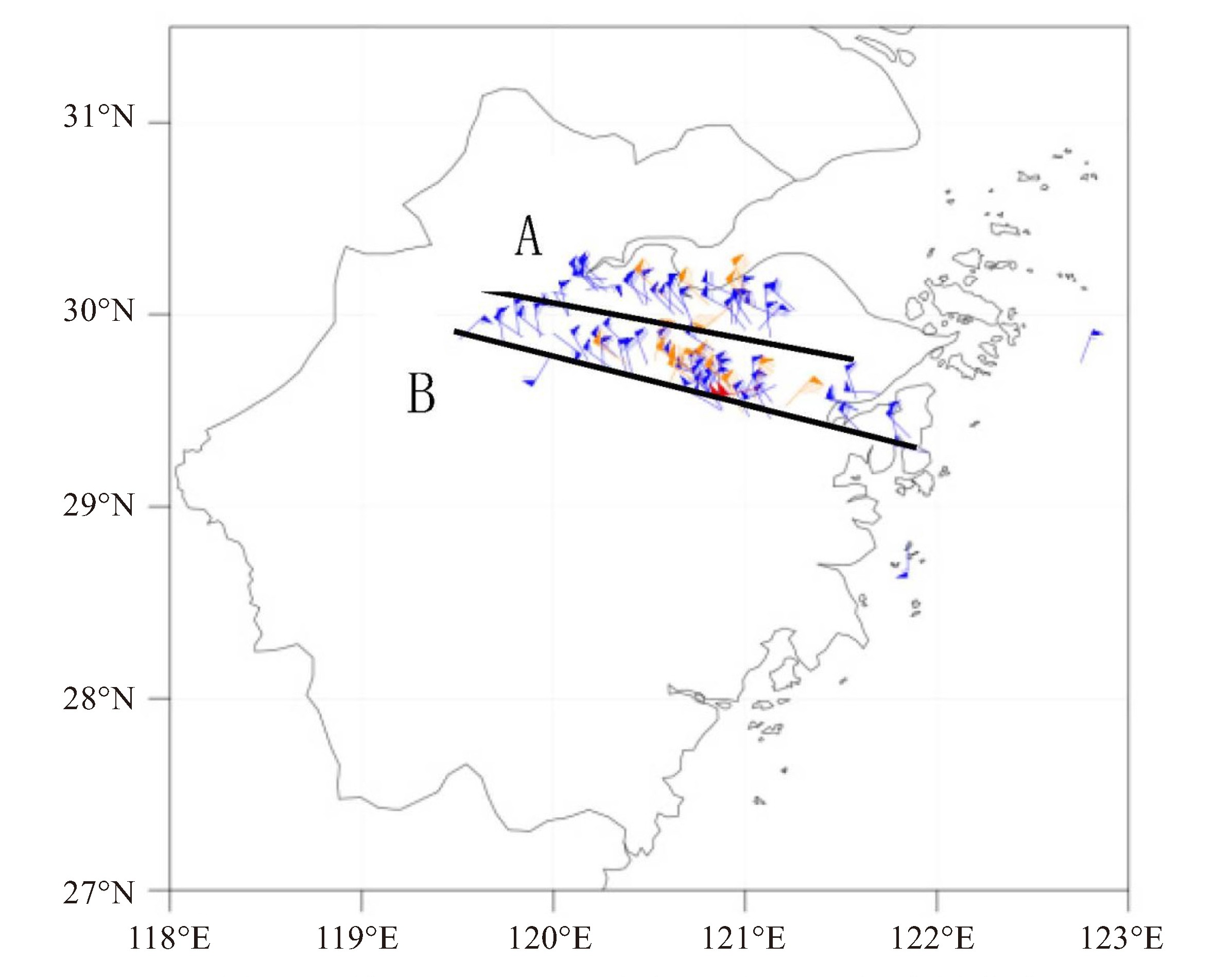Doppler Radar Characteristics and Cause Analysis of a Continuous Downburst in Zhejiang
-
摘要: 利用常规高空、地面观测资料、ERA5再分析资料(0.25 °×0.25 °)、多普勒雷达产品对2020年3月21日浙江连续下击暴流的多普勒雷达特征及成因进行分析。(1) 此次过程发生在中高层西南急流、地面低压倒槽强烈发展的环流背景下,为低层暖平流强迫型强对流。整层大气湿层浅薄,近地面逆温和中层干冷增强了上干冷下暖湿的不稳定层结,高空强垂直风切变有利于强风暴的形成和发展,地面中尺度辐合线在高温背景下触发了此次过程。(2) 连续下击暴流由2个多单体风暴造成,两个风暴均呈现“弓形”特征,具有中层回波悬垂、有界弱回波区、三体散射等特征。单体K0中极端大风出现在最大反射率因子高度、风暴顶高、VIL下降阶段,而单体Y5中极端大风出现时风暴顶高、最大反射率因子高度、反射率因子核高度稳定少变。(3) 10级以上下击暴流主要出现在涡度平流强烈发展、中层有弱冷空气入侵阶段。单体K0中致灾下击暴流主要由冰雹的拖拽作用产生,而单体Y5中致灾下击暴流由冰雹和短时强降水共同的拖拽作用产生。Abstract: Using routine observation data, ERA5 hourly reanalysis data (0.25 ° × 0.25 °) and Doppler weather radars in Zhejiang Province, this paper analyzed the doppler radar characteristics and cause of the event that occurred on March 21, 2020. The results showed that: (1) This process occurred under the background of strong development of the southwest jet at the middle and upper levels and the surface low-pressure trough which was a forced strong convection of the low-level warm advection. The wet layer of the whole atmosphere was shallow, the near surface inversion and the middle dry cooling layer enhanced the unstable stratification with dry and cold upper and warm and wet lower, while the strong vertical wind shear in the upper air was conducive to the formation and development of strong storms, and the surface mesoscale convergence line triggered this process under the high temperature background. (2) The downburst was caused by two multi-cell storms exhibiting"Bow Echo"characteristics, including mid-level echo overhang, bounded weak echo zone, and three-body scattering. Extreme winds occurred during the descending phase of maximum reflectivity factor altitude, storm crest height, and VIL descent in unit K0, while the maximum reflectivity factor altitude, storm crest height, and reflectivity factor kernel remained relatively stable in unit Y5. (3) The downburst above level 10 primarily occurred during the stage of strong development of vorticity advection and weak cold air intrusion in the middle layer. The disaster-causing downburst in unit K0 was mainly generated by the dragging effect of hail, while in unit Y5, it was generated by the combined dragging effect of hail and short-term heavy precipitation.
-
Key words:
- downburst /
- supercell /
- mesocyclone /
- ground convergence line
-
图 7 风暴单体Y5参数演变
说明同图 6。
表 1 3月21日风暴单体Y5中气旋阶段不同时刻属性列表
时间 底高/km 顶高/km 最强切变高度/km 旋转速度/(m·s-1) 强度 径向距离/km 17:34 0.7 2.7 0.7 16 弱 59.4 17:40 0.6 2.7 0.6 19 中等 56.8 17:46 0.8 4.2 0.8 19 中等 65.2 17:51 2.2 4.4 2.2 14 弱 76.0 17:57 4.5 5.9 4.5 15 弱 72.7 -
[1] FUJITA T T. Manual of downburst identification for Project NIMROD[J]. Satellite and Mesometeorology Research, 1978, 104(4): 56. [2] SMITH T M, ELMORE K L, DULIN S A. A damaging downburst prediction and detection algorithm for the WSR-88D[J]. Wea Forecasting, 2004, 19(2): 240-250. [3] WAKIMOTO R M. Forecasting dry microburst activity over High Plains[J]. Mon Wea Rev, 1985, 113(7): 1 131-1 143. [4] 俞小鼎, 张爱民, 郑媛媛, 等. 一次系列下击暴流事件的多普勒天气雷达分析[J]. 应用气象学报, 2006, 17(4): 385-393. [5] 翟丽萍, 农孟松, 梁维亮, 等. 造成临桂极端大风的超级风暴单体观测分析[J]. 暴雨灾害, 2019, 38(4): 346-353. [6] MOLLER A R, DOSWELL C A, FOSTER M P, et al. The operational recognition of supercell thunderstorm environments and storm structures[J]. Wea Forecasting, 1994, 9(3): 327-347. [7] BROOKS H E, DOSWELL C A. Extreme winds in high-precipitation supercells[C] // Preprints of 17th Conf on Severe Local Storms. Amer Meteor Soc, St Louis MO, 1993: 177. [8] 李彩玲, 蔡康龙, 黄先香, 等. 桂林一次强下击暴流成因分析[J]. 气象, 2021, 47(2): 242-252. [9] 王艳兰, 王娟, 伍静, 等. 桂林市2019年"3.21"极端大风与"4.24"致灾冰雹过程特征对比分析[J]. 热带气象学报, 2021, 37(2): 175-185. [10] 梁虹, 王盛繁, 梁毅进, 等. 贵港市"5.20"下击暴流过程超级单体结构演变与环境特征分析[J]. 暴雨灾害, 2022, 41(6): 631-639. [11] 王一童, 王秀明, 俞小鼎, 等. 两个超级单体导致的冀豫交界区极端下击暴流预警分析[J]. 暴雨灾害, 2022, 41(3): 254-265. [12] 孙凌峰, 郭学良, 孙立潭, 等. 武汉"6.22"空难下击暴流的三维数值模拟研究[J]. 大气科学, 2003, 27(6): 1 077-1 092. [13] ROBERTS R D, WILSON J W. A proposed microburst nowcasting procedure using single-Doppler radar[J]. J Appli Meteor, 1989, 28(4): 285-303. [14] 王艳春, 尉英华, 张楠, 等. 2017年夏季天津一次下击暴流时间的成因初探[J]. 暴雨灾害, 2022, 41(5): 556-563. [15] 王秀明, 俞小鼎, 周小刚, 等. "6.3"区域致灾雷暴大风形成及维持原因分析[J]. 高原气象, 2012, 31(2): 504-514. [16] 樊李苗, 俞小鼎. 杭州地区夏季午后雷暴大风环境条件分析[J]. 气象, 2020, 46(12): 1 621-1 632. [17] 俞小鼎, 姚秀萍, 熊廷南, 等. 多普勒天气雷达原理与业务应用[M]. 北京: 气象出版社, 2006: 157-158, 93-94. [18] 仇娟娟, 何立富. 苏浙沪地区短时强降水与冰雹天气分布及物理量特征对比分析[J]. 气象, 2013, 39(5): 577-584. [19] JOHNS H R, DOSWELL C A. Sever local storms forecasting[J]. Wea Forecasting, 1992, 7(4): 588-612. [20] 俞小鼎, 周小刚, 王秀明. 雷暴与强对流临近天气预报技术进展[J]. 气象学报, 2012, 70(3): 311-337. [21] 李胜山, 张殿江, 胡玲, 等. 一次下击暴流显著弓形回波特征[J]. 气象与环境学报, 2012, 28(4): 84-89. [22] 许爱华, 孙继松, 许东蓓, 等. 中国中东部强对流天气的天气形势分类和基本要素配置特征[J]. 气象, 2014, 40(4): 400-411. [23] 孙继松, 戴建华, 何立富, 等. 强对流天气预报的基本原理与技术方法[M]. 北京: 气象出版社, 2014: 282. [24] KINGSMILL D E, WAKIMOTO R M. Kinematic, dynamic, and thermodynamic analysis of a weakly sheared severe thunderstorm over Northern Alabama[J]. Mon Wea Rev, 1991, 119(2): 262-297. [25] 付丹红, 郭学良, 肖稳安, 等. 北京一次大风和强降水天气过程形成机理的数值模拟[J]. 南京气象学报, 2003, 26(2): 190-200. [26] 周后福, 刁秀广, 赵倩, 等. 一次连续下击暴流天气的成因分析[J]. 干旱气象, 2017, 35(4): 641-648. -






 下载:
下载:











 粤公网安备 4401069904700003号
粤公网安备 4401069904700003号